The Telemedicine Carts Market is estimated to be valued at USD 1.2 billion in 2025 and is projected to reach USD 5.5 billion by 2035, registering a compound annual growth rate (CAGR) of 16.8% over the forecast period.
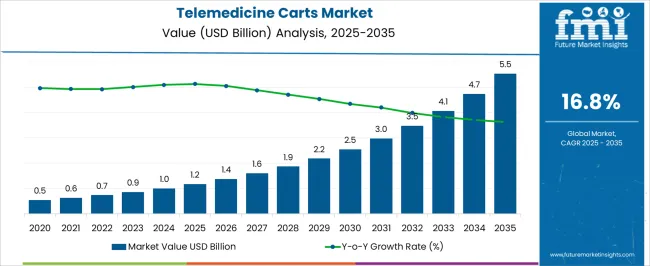
| Metric | Value |
|---|---|
| Telemedicine Carts Market Estimated Value in (2025 E) | USD 1.2 billion |
| Telemedicine Carts Market Forecast Value in (2035 F) | USD 5.5 billion |
| Forecast CAGR (2025 to 2035) | 16.8% |
The Telemedicine Carts market is experiencing substantial growth, driven by the increasing demand for remote healthcare delivery and the need to expand access to medical services in both urban and rural areas. The adoption of telemedicine solutions has been accelerated by rising patient expectations for convenience, improvements in healthcare infrastructure, and the integration of advanced medical technologies. The market is also being shaped by the rising prevalence of chronic diseases, aging populations, and the need for continuous patient monitoring without physical visits.
Telemedicine carts allow healthcare providers to conduct virtual consultations efficiently while maintaining access to diagnostic tools and patient data in real time. The flexibility to deploy these systems across hospitals, clinics, and specialized care facilities enhances operational efficiency.
Additionally, investments in telehealth policies and digital healthcare initiatives are creating opportunities for broader adoption With ongoing technological innovations in imaging, connectivity, and cloud-based patient management, the market is positioned for sustained expansion, providing scalable solutions for both healthcare providers and patients seeking accessible and high-quality care.
The telemedicine carts market is segmented by product type, technology type, application, end user, and geographic regions. By product type, telemedicine carts market is divided into Dual Display Telemedicine Cart and Single Display Telemedicine Cart. In terms of technology type, telemedicine carts market is classified into Store-And-Forward Telemedicine Carts, Remote Patient Monitoring Telemedicine Carts, and Real-Time Encounters Telemedicine Carts. Based on application, telemedicine carts market is segmented into Telemedicine Carts For Cardiology, Telemedicine Carts For Dermatology, Telemedicine Carts For Liver Disease, Telemedicine Carts For Dental Care, Telemedicine Carts For Rehabilitation, and Telemedicine Carts For Other Applications. By end user, telemedicine carts market is segmented into Telemedicine Carts Usage In Hospitals, Telemedicine Carts Usage In Specialty Clinics, and Telemedicine Carts Usage In Homecare Settings. Regionally, the telemedicine carts industry is classified into North America, Latin America, Western Europe, Eastern Europe, Balkan & Baltic Countries, Russia & Belarus, Central Asia, East Asia, South Asia & Pacific, and the Middle East & Africa.
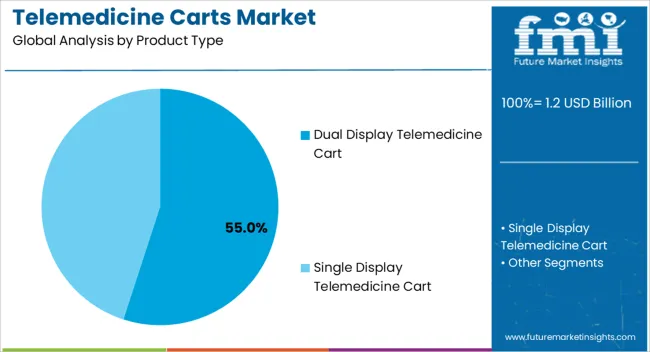
The Dual Display Telemedicine Cart segment is projected to hold 55.00% of the Telemedicine Carts market revenue in 2025, making it the leading product type. This dominance is being driven by its ability to enhance the interaction between healthcare providers and patients by offering simultaneous views of diagnostic data and video consultations.
Adoption has been accelerated by the need for improved clinical workflows, as dual displays allow physicians to view patient records, imaging results, and live consultation streams simultaneously. The segment has benefited from the rising emphasis on patient engagement, real-time monitoring, and interactive telehealth experiences.
The modular design and ease of mobility also contribute to its popularity, enabling deployment across multiple departments or locations without requiring additional infrastructure As hospitals and clinics continue to prioritize efficiency and integrated care delivery, the Dual Display Telemedicine Cart segment is expected to maintain leadership due to its superior functionality, scalability, and adaptability to evolving telehealth requirements.
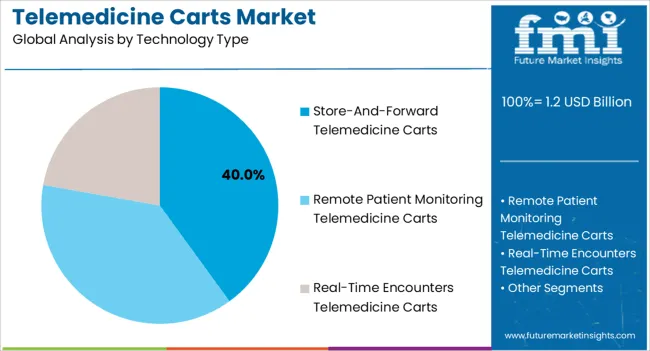
The Store-And-Forward Telemedicine Carts segment is expected to account for 40.00% of the overall market in 2025, making it a significant application type. This growth is being attributed to the ability to securely capture, store, and transmit patient data such as images, vital signs, and medical records for remote review by specialists.
Adoption has been supported by increasing demand for asynchronous telemedicine consultations, which allow healthcare professionals to review information at convenient times, improving workflow efficiency and patient throughput. The segment has been strengthened by improvements in secure data storage technologies, integration with electronic health records, and compliance with healthcare regulations for data privacy.
Store-and-Forward Telemedicine Carts offer flexibility for hospitals and clinics that require reliable solutions for departments with high patient volumes or limited specialist availability The segment’s growth is expected to continue as healthcare providers increasingly prioritize efficiency, cost-effectiveness, and quality of care delivery across multiple medical disciplines.
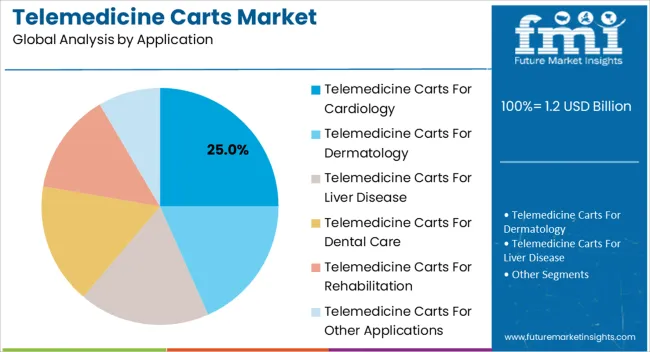
The Telemedicine Carts for Cardiology segment is projected to hold 25.00% of the market revenue in 2025, representing the leading application within specialized medical care. Growth in this segment is being driven by the rising prevalence of cardiovascular diseases and the need for remote monitoring of patients with chronic cardiac conditions.
Adoption has been facilitated by the integration of diagnostic tools such as ECG monitors, blood pressure sensors, and imaging systems, enabling cardiologists to conduct thorough assessments without requiring patients to travel. Telemedicine Carts for Cardiology have also benefited from increasing demand for continuous patient monitoring and early intervention capabilities, which help reduce hospital readmissions and improve clinical outcomes.
Hospitals and specialty clinics are increasingly investing in these carts to enhance cardiac care delivery, optimize resource utilization, and ensure real-time data accessibility The segment is expected to maintain growth momentum as telehealth initiatives expand and cardiovascular care increasingly leverages remote monitoring and software-enabled solutions.
Telemedicine carts have the potential to help facilitate the delivery of health services to areas that lack hospitals for the treatment of major diseases. Modern advancements in information communications technologies have seen developments in different mechanisms for conducting telemedicine. Telemedicine carts can be used for different purposes such as clinical, educational, and administrative which create huge opportunities in the coming years for the telemedicine carts market to grow.
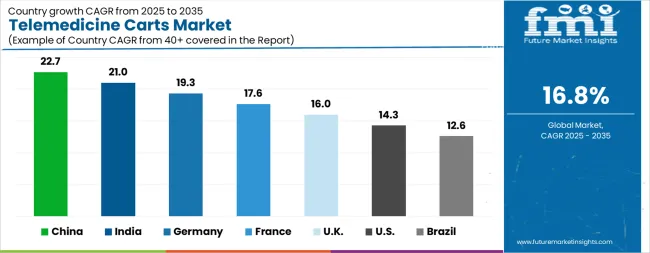
| Country | CAGR |
|---|---|
| China | 22.7% |
| India | 21.0% |
| Germany | 19.3% |
| France | 17.6% |
| UK | 16.0% |
| USA | 14.3% |
| Brazil | 12.6% |
The Telemedicine Carts Market is expected to register a CAGR of 16.8% during the forecast period, exhibiting varied country level momentum. China leads with the highest CAGR of 22.7%, followed by India at 21.0%. Developed markets such as Germany, France, and the UK continue to expand steadily, while the USA is likely to grow at consistent rates. Brazil posts the lowest CAGR at 12.6%, yet still underscores a broadly positive trajectory for the global Telemedicine Carts Market. In 2024, Germany held a dominant revenue in the Western Europe market and is expected to grow with a CAGR of 19.3%. The USA Telemedicine Carts Market is estimated to be valued at USD 429.7 million in 2025 and is anticipated to reach a valuation of USD 1.6 billion by 2035. Sales are projected to rise at a CAGR of 14.3% over the forecast period between 2025 and 2035. While Japan and South Korea markets are estimated to be valued at USD 55.2 million and USD 30.4 million respectively in 2025.
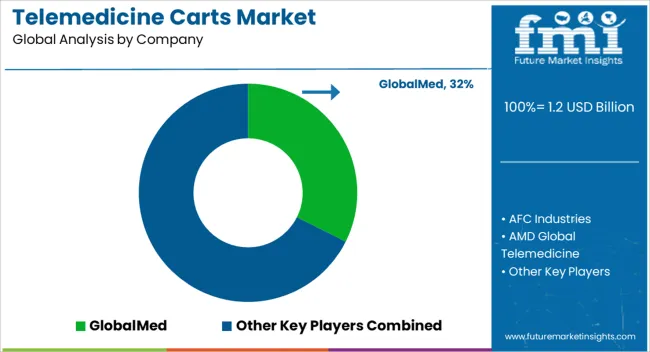
| Item | Value |
|---|---|
| Quantitative Units | USD 1.2 Billion |
| Product Type | Dual Display Telemedicine Cart and Single Display Telemedicine Cart |
| Technology Type | Store-And-Forward Telemedicine Carts, Remote Patient Monitoring Telemedicine Carts, and Real-Time Encounters Telemedicine Carts |
| Application | Telemedicine Carts For Cardiology, Telemedicine Carts For Dermatology, Telemedicine Carts For Liver Disease, Telemedicine Carts For Dental Care, Telemedicine Carts For Rehabilitation, and Telemedicine Carts For Other Applications |
| End User | Telemedicine Carts Usage In Hospitals, Telemedicine Carts Usage In Specialty Clinics, and Telemedicine Carts Usage In Homecare Settings |
| Regions Covered | North America, Europe, Asia-Pacific, Latin America, Middle East & Africa |
| Country Covered | United States, Canada, Germany, France, United Kingdom, China, Japan, India, Brazil, South Africa |
| Key Companies Profiled | GlobalMed, AFC Industries, AMD Global Telemedicine, American Well, Ergotron, First Healthcare Products (Cura Carts), Poly InTouch, and Parsys |
The global telemedicine carts market is estimated to be valued at USD 1.2 billion in 2025.
The market size for the telemedicine carts market is projected to reach USD 5.5 billion by 2035.
The telemedicine carts market is expected to grow at a 16.8% CAGR between 2025 and 2035.
The key product types in telemedicine carts market are dual display telemedicine cart and single display telemedicine cart.
In terms of technology type, store-and-forward telemedicine carts segment to command 40.0% share in the telemedicine carts market in 2025.






Our Research Products

The "Full Research Suite" delivers actionable market intel, deep dives on markets or technologies, so clients act faster, cut risk, and unlock growth.

The Leaderboard benchmarks and ranks top vendors, classifying them as Established Leaders, Leading Challengers, or Disruptors & Challengers.

Locates where complements amplify value and substitutes erode it, forecasting net impact by horizon

We deliver granular, decision-grade intel: market sizing, 5-year forecasts, pricing, adoption, usage, revenue, and operational KPIs—plus competitor tracking, regulation, and value chains—across 60 countries broadly.

Spot the shifts before they hit your P&L. We track inflection points, adoption curves, pricing moves, and ecosystem plays to show where demand is heading, why it is changing, and what to do next across high-growth markets and disruptive tech

Real-time reads of user behavior. We track shifting priorities, perceptions of today’s and next-gen services, and provider experience, then pace how fast tech moves from trial to adoption, blending buyer, consumer, and channel inputs with social signals (#WhySwitch, #UX).

Partner with our analyst team to build a custom report designed around your business priorities. From analysing market trends to assessing competitors or crafting bespoke datasets, we tailor insights to your needs.
Supplier Intelligence
Discovery & Profiling
Capacity & Footprint
Performance & Risk
Compliance & Governance
Commercial Readiness
Who Supplies Whom
Scorecards & Shortlists
Playbooks & Docs
Category Intelligence
Definition & Scope
Demand & Use Cases
Cost Drivers
Market Structure
Supply Chain Map
Trade & Policy
Operating Norms
Deliverables
Buyer Intelligence
Account Basics
Spend & Scope
Procurement Model
Vendor Requirements
Terms & Policies
Entry Strategy
Pain Points & Triggers
Outputs
Pricing Analysis
Benchmarks
Trends
Should-Cost
Indexation
Landed Cost
Commercial Terms
Deliverables
Brand Analysis
Positioning & Value Prop
Share & Presence
Customer Evidence
Go-to-Market
Digital & Reputation
Compliance & Trust
KPIs & Gaps
Outputs
Full Research Suite comprises of:
Market outlook & trends analysis
Interviews & case studies
Strategic recommendations
Vendor profiles & capabilities analysis
5-year forecasts
8 regions and 60+ country-level data splits
Market segment data splits
12 months of continuous data updates
DELIVERED AS:
PDF EXCEL ONLINE
Telemedicine Equipment Market Size and Share Forecast Outlook 2025 to 2035
5G Telemedicine Platform Market Size and Share Forecast Outlook 2025 to 2035
Veterinary Telemedicine Market Size and Share Forecast Outlook 2025 to 2035
Telehealth and Telemedicine Market Growth - Trends & Forecast 2025 to 2035
Medical Carts Market Analysis - Size, Share, and Forecast Outlook 2025 to 2035
Banquet Carts Market – Large-Scale Catering & Mobility 2025-2035
Banquet Carts and Heated Cabinets Market
Industrial Carts Market Growth - Trends & Forecast 2025 to 2035
Merchandizing Carts Market - Mobile Retail & Food Display 2025 to 2035
Surgical Case Carts Market
Kitchen Islands and Carts Market
North America Medical Carts Market Growth – Trends & Forecast 2025 to 2035

Thank you!
You will receive an email from our Business Development Manager. Please be sure to check your SPAM/JUNK folder too.
Chat With
MaRIA